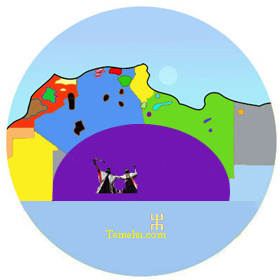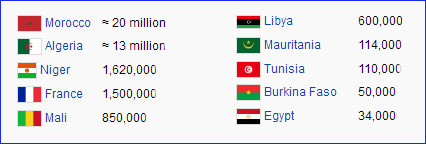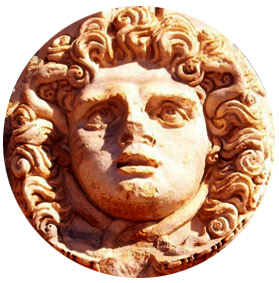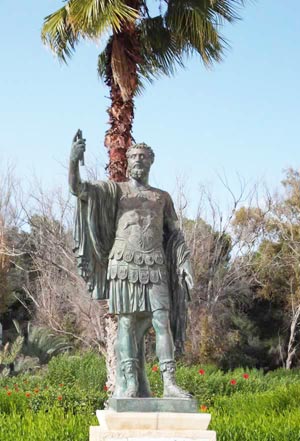Morocco is indigenous Amazigh

MOROCCO'S INDIGENOUS BERBER PEOPLE ARE STRUGGLING TO MAKE THEIR VOICES HEARD DESPITE THEIR ANCIENT AMAZIGH LANGUAGE WINNING OFFICIAL RECOGNITION IN 2011. (FADEL SENNA/AFP/GETTY IMAGES)
In North Africa, Berber women have banded together to fight political Islamism, polygamy, child marriage, and impunity for perpetrators of domestic violence.
Their ancestors in ancient Carthage worshipped goddesses and venerated female warriors, queens, prophetesses and poets, but today the indigenous women of North Africa?s Amazigh or ?Berber? people say their matriarchal traditions and native language are under threat from Arab elites and burgeoning Islamism.
In Morocco, home to the largest population descended from the region?s original inhabitants, activists blame the dominant contemporary Arabic culture as well as imported religious extremism and ideologies aligned with Islamic State. ?Women?s groups always speak of ?the Arab woman? but we are not Arab women ? we have an Amazigh culture, language and identity which has nothing to do with the Arab woman from the Middle East,? Amina Zioual, President of The Voice of the Amazigh Woman told Women in the World.
Feminist activists ? Amazigh means free men or ?freeborn? ? argue they are ?doubly oppressed? for being female and indigenous, and are usually ignored by Arab feminists. So they have banded together to fight for recognition of their rights in the face of ?Arabization? ? official government policy since independence from France more than half a century ago ? political Islamism, persistent polygamy, underage marriage, and impunity for perpetrators of domestic violence.



Morocco?s first official Amazigh women?s association is pushing for access to justice, health and education. It says Berber women are members of an ethnic majority ? there are no official figures but some estimates put the Amazigh population as high as 70 percent ? yet are treated as a minority by a political regime privileging the Arabic language and conservative Islam.
?We created our group because the Amazigh woman ? who typically speaks her native Tamazight, not French or Arabic ? is not listened to and is even marginalized by the system in Morocco,? says Zioual.
?We have been in all the countries of North Africa for 3,000 years. We are oppressed by our government. They are always talking about Arabs but we are fighting to rewrite the history of Morocco.?
Outside of the southern Mediterranean, Morocco, Algeria, Tunisia and Libya are typically assumed to be homogenous Arab-Muslim majority nations, where French is often also spoken because of the colonial past.
However, Amazigh groups insist there are around 25 million Berbers in North Africa, including two-thirds of Moroccans because they are descended from original inhabitants who predated the Romans, the Arab Muslim conquests beginning in the 7th century and later French colonizers.
?We want to debunk the common myth that Morocco is an exclusively Arab country and challenge our forced assimilation,? says The Voice of the Amazigh Woman on its online platform, highlighting its official United Nations? recognition as an indigenous people.
?The government wants to classify us as a minority people. We are more than 67 per cent of the population but there is a political program of ?Arabizing? the population so that Arabic is the predominant mother tongue.

Amina Zioual, President of The Voice of the Amazigh Woman.
Even if most Berbers have been Muslim for many centuries, Amazigh women want secularism, tolerance and religious diversity to be accepted too. ?We are not all Islamic or Arab ? we are also Jews and Christians and non-believers and we want a Morocco that is multi-cultural and where everybody can feel at home,? says Zioual.
The Voice of the Amazigh Woman prioritizes servicing poor indigenous women living in remote areas outside the big cities. These vulnerable groups are excluded because they are overwhelmingly illiterate (more than 70 percent of Moroccan women in country areas cannot read or write and the figures are much higher for Amazigh women) and they don?t speak Arabic or French. ?Amazigh women are at the receiving end of all the violence Moroccan woman in general suffer,? says Zioual. ?But then they are further marginalized because they cannot communicate in their language with government agencies, hospitals and the justice system where Arabic is almost compulsory.?
Following a sustained campaign, the Amazigh succeeded in 2011 in forcing the government to recognize their mother tongue Tamazight as the second national language. ?Unfortunately the reality is that this has not been put into practice,? explains Zioual.
Profiled in a new book Feminists of the Arab World, by French journalist Charlotte Bienaime, The Voice of the Amazigh Woman counts secular and religious, veiled women, Muslims and non-believers among its supporters.
Despite most Amazigh women today being Muslims, feminists claim their culture?s traditional interpretation of the religion of the ?invaders? did not involve men having multiple wives or women being considered as their chattels.
Zioual points the finger at the imposition of harshly patriarchal customs from the Middle East, particularly in recent decades. ?The active marginalization and oppression of women has come from Arab countries ? it is the Arab male who has this culture,? she says of escalating pressure on women to be heavily veiled, and the enduring practice of ?repudiation? (instant male-pronounced divorce), polygamy and an unwillingness to punish men who beat their wives.
?But in our culture the woman is queen,? she said. ?We never experienced polygamy until the arrival of Arab culture. And now the problem has been aggravated with the arrival of the Islam of Daesh (Islamic State) which has penetrated regional areas? ? a problem Zioual says the Moroccan government too often turns a blind eye to.
Morocco was recently severely criticized in a Human Rights Watch report for its abysmal treatment of women victims of domestic violence.
Although Western nations sometimes hail Morocco as an example of ?moderate Islam? when it comes to women?s status, around 10 percent of marriages involve girls under 18, and in rural areas they can be as young as 13.
Moroccan law allows a girl?s guardian to ask a judge for an exemption. The penal code also allows rapists to escape prosecution if they marry their victims, leading to horrifying cases of abuse, particularly in conservative country areas where families pressure girls to marry their attackers to avoid the social opprobrium and reduced marriage prospects for those known to no longer be virgins.
The Voice of the Amazigh Woman cites the 2012 case of a 16 year-old girl Amina Filali, who drank rat poison and died after being forced to marry and live for several months with the man who raped her. A woman who wants to divorce her husband meanwhile faces a legal and social minefield, while the procedure is relatively easy for men. ?Since 2004 in Morocco, a man is not supposed to repudiate and divorce his wife and take another spouse without her unforced permission. But the reality is most women don?t know they have these rights or can?t exercise them,? says Zioual.
?With this government presided over by an Islamic political party there is always the pressure to put an Islamic reference into all the laws. But as a feminist movement we denounce all these changes to the civil code and the penal and family code.?
For Zioual a pressing problem in today?s Morocco is that ?everything is seen through the Islamic prism.?
?Twenty years ago in regional areas you could go out without a veil or a headscarf, and you could wear a skirt or pants. But that doesn?t exist anymore in the provinces ? it is either the headscarf or the jellaba that are obligatory.
?This is all imposed by religion but also by the culture in our media, and on the radio. There have been radical changes and they have been pushing this for 50 years since Independence (from France).?
Women are sold the lie that in order to enter paradise they must be veiled and obey men, says Zioual. ?Most Moroccan women are illiterate, and don?t have financial resources. They depend on their husband so they tend to obey this culture that tells them not to ask for anything, whether it is schools, hospitals or roads. They are told if they are you are calm and placid they will go to paradise.?
The association?s next project is to lift the voter participation of Amazigh women in local and national elections. It has worked closely with Spain?s Catalan Agency for Development Cooperation in trying to make young girls and women aware of the importance of finishing school and not marrying until the legal age of 18.
Women in regional areas like the Atlas Mountains are educated about their legal rights when it comes to marriage and divorce ? and the importance of obtaining official papers when they wed, to avoid being thrown out later by a husband taking the ?back door? to polygamy or marriage with an underage girl. ?We have a problem in the family legal code which indirectly encourages men to take minor wives,? says Zioual.
?There are some regions where men and women are married by Imams without having official papers. Then when the man doesn?t need his wife anymore she has no proof of the marriage. Men have taken advantage of the practice to remarry with minors or to be polygamous. We are pushing for women to be able to officialize these marriages.?
Asked why she decided to found the association, Zioual, a married banker with a daughter, says she experienced firsthand the sense of exclusion and discrimination in elementary school when she realized she did not speak or understand Arabic like most of her classmates. ?Injustice and violence pushed me to work in different human rights and women?s groups, but the particular needs of Amazigh women were never discussed so we were obliged to found our own association,? she said.
?I will always be a feminist because when you live in Morocco and you see everything a woman must submit to, you automatically become feminist.?
Follow Emma-Kate Symons on Twitter @eksymons
From : NTimes
Auteur: EMMA-KATE SYMONS
Date : 2016-03-28
Etiquetas: Amazigh, and Arab, elites, is indigenous, Islamists, Morocco, unite against, women








